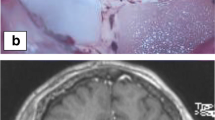Abstract
Cerebral radiation necrosis (CRN) is a known complication of radiation therapy. Treatment options are limited and include steroids, bevacizumab, and surgery. This study seeks to determine the safety of laser interstitial thermal therapy (LITT) for CRN and identify the pattern of post-ablation volume change over time. Patients undergoing LITT for tumor treatment at Henry Ford Hospital between November 2013 and January 2016 with biopsy-confirmed CRN were prospectively collected and retrospectively reviewed with attention to ablation volume, survival, demographic data, steroid dose, and complications. Imaging occurred at set intervals beginning pre-ablation. Ten patients with 11 ablations were evaluated. Four patients had a primary diagnosis of high-grade glioma, while six had metastatic lesions. An average of 86% of CRN volume was ablated. Ablation volume increased to 430% of initial CRN volume at 1–2 weeks before decreasing to 69% after 6 months. No patient had a decline in baseline neurological examination while in the hospital. Four patients developed delayed neurological deficits likely due to post-operative edema, of which three improved back to baseline. The 6-month survival was 77.8% and the 1-year survival was 64.8% based on Kaplan–Meier curve estimates. In this study, LITT was a relatively safe treatment for CRN, providing both a diagnostic and therapeutic solution for refractory patients. Significant increase in ablation volume was noted at 1–2 months, gradually decreasing in size to less than the original volume by 6 months. Further studies are needed to better define the role of LITT in the treatment of CRN.




Similar content being viewed by others
References
Chao ST, Ahluwalia MS, Barnett GH et al (2013) Challenges with the diagnosis and treatment of cerebral radiation necrosis. Int J Radiat Oncol Biol Phys 87:449–457. https://doi.org/10.1016/j.ijrobp.2013.05.015
Siu A, Wind JJ, Iorgulescu JB et al (2012) Radiation necrosis following treatment of high grade glioma—a review of the literature and current understanding. Acta Neurochir (Wien) 154:191–201. https://doi.org/10.1007/s00701-011-1228-6; discussion 201.
Rahmathulla G, Recinos PF, Valerio JE et al (2012) Laser interstitial thermal therapy for focal cerebral radiation necrosis: a case report and literature review. Stereotact Funct Neurosurg 90:192–200. https://doi.org/10.1159/000338251
Furuse M, Nonoguchi N, Kawabata S et al (2015) Delayed brain radiation necrosis: pathological review and new molecular targets for treatment. Med Mol Morphol 48:183–190. https://doi.org/10.1007/s00795-015-0123-2
Rao MS, Hargreaves EL, Khan AJ et al (2014) Magnetic resonance-guided laser ablation improves local control for postradiosurgery recurrence and/or radiation necrosis. Neurosurgery 74:658–667. https://doi.org/10.1227/NEU.0000000000000332; discussion 667.
Carpentier A, McNichols RJ, Stafford RJ et al (2008) Real-time magnetic resonance-guided laser thermal therapy for focal metastatic brain tumors. Neurosurgery 63:ONS21–ONS2128. https://doi.org/10.1227/01.neu.0000335007.07381.df; discussion ONS28-29.
Patel P, Patel NV, Danish SF (2016) Intracranial MR-guided laser-induced thermal therapy: single-center experience with the Visualase thermal therapy system. J Neurosurg 125:853–860. https://doi.org/10.3171/2015.7.JNS15244
Carpentier A, Chauvet D, Reina V et al (2012) MR-guided laser-induced thermal therapy (LITT) for recurrent glioblastomas. Lasers Surg Med 44:361–368. https://doi.org/10.1002/lsm.22025
Sloan AE, Ahluwalia MS, Valerio-Pascua J et al (2013) Results of the NeuroBlate system first-in-humans Phase I clinical trial for recurrent glioblastoma: clinical article. J Neurosurg 118:1202–1219. https://doi.org/10.3171/2013.1.JNS1291
Hawasli AH, Bagade S, Shimony JS et al (2013) Magnetic resonance imaging-guided focused laser interstitial thermal therapy for intracranial lesions: single-institution series. Neurosurgery 73:1007–1017. https://doi.org/10.1227/NEU.0000000000000144
Burrows AM, Marsh WR, Worrell G et al (2016) Magnetic resonance imaging-guided laser interstitial thermal therapy for previously treated hypothalamic hamartomas. Neurosurg Focus 41:E8. https://doi.org/10.3171/2016.7.FOCUS16218
Tovar-Spinoza Z, Choi H (2016) MRI-guided laser interstitial thermal therapy for the treatment of low-grade gliomas in children: a case-series review, description of the current technologies and perspectives. Childs Nerv Syst 32:1947–1956. https://doi.org/10.1007/s00381-016-3193-0
Kang JY, Wu C, Tracy J et al (2016) Laser interstitial thermal therapy for medically intractable mesial temporal lobe epilepsy. Epilepsia 57:325–334. https://doi.org/10.1111/epi.13284
Li Y-Q, Chen P, Haimovitz-Friedman A et al (2003) Endothelial apoptosis initiates acute blood-brain barrier disruption after ionizing radiation. Cancer Res 63:5950–5956
Murovic JA, Chang SD (2015) The pathophysiology of cerebral radiation necrosis and the role of laser interstitial thermal therapy. World Neurosurg 83:23–26. https://doi.org/10.1016/j.wneu.2014.03.015
Brandes AA, Franceschi E, Tosoni A et al (2008) MGMT promoter methylation status can predict the incidence and outcome of pseudoprogression after concomitant radiochemotherapy in newly diagnosed glioblastoma patients. J Clin Oncol Off J Am Soc Clin Oncol 26:2192–2197. https://doi.org/10.1200/JCO.2007.14.8163
Lai G, Mahadevan A, Hackney D et al (2015) Diagnostic accuracy of PET, SPECT, and arterial spin-labeling in differentiating tumor recurrence from necrosis in cerebral metastasis after stereotactic radiosurgery. AJNR Am J Neuroradiol 36:2250–2255. https://doi.org/10.3174/ajnr.A4475
Smith CJ, Myers CS, Chapple KM, Smith KA (2016) Long-term follow-up of 25 cases of biopsy-proven radiation necrosis or post-radiation treatment effect treated With magnetic resonance-guided laser interstitial thermal therapy. Neurosurgery 79(Suppl 1):S59–S72. https://doi.org/10.1227/NEU.0000000000001438
Beechar VB, Prabhu SS, Bastos D, Weinberg JS, Stafford RJ, Fuentes D, Hess KR, Rao G (2017) Volumetric response of progressing post-SRS lesions treated with laser interstitial thermal therapy. J Neurooncol 137:57–65
Funding
This study was supported by Harris Neurosciences Grant, #H1094.
Author information
Authors and Affiliations
Corresponding author
Ethics declarations
Conflict of interest
Ian Lee has consulting agreements with Monteris and Visualase.
Rights and permissions
About this article
Cite this article
Rammo, R., Asmaro, K., Schultz, L. et al. The safety of magnetic resonance imaging-guided laser interstitial thermal therapy for cerebral radiation necrosis. J Neurooncol 138, 609–617 (2018). https://doi.org/10.1007/s11060-018-2828-2
Received:
Accepted:
Published:
Issue Date:
DOI: https://doi.org/10.1007/s11060-018-2828-2




